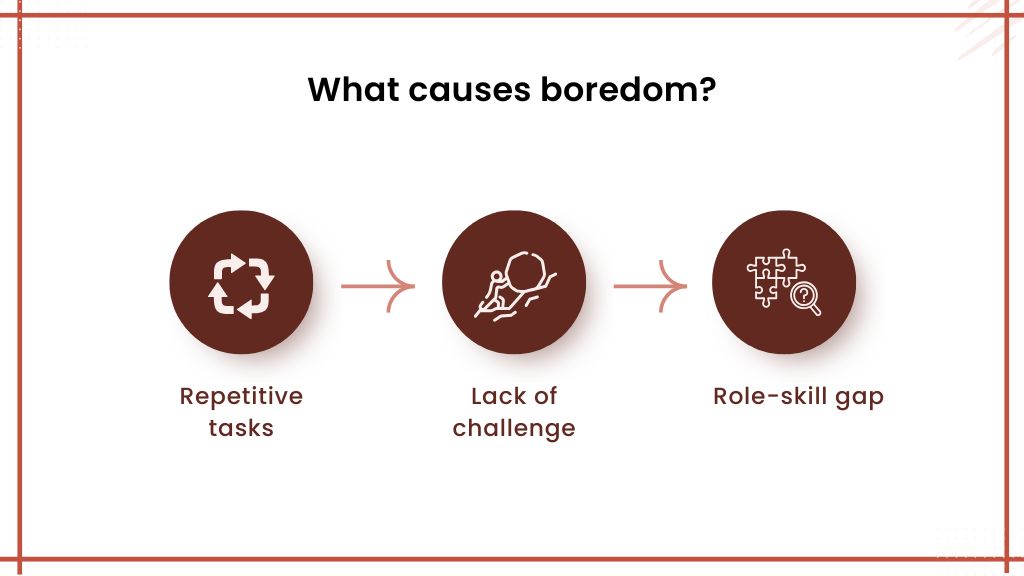Some days, your team operates with high energy and enthusiasm—knocking tasks off their lists effortlessly. Other days, they seem overwhelmed and disengaged, struggling to make progress. These fluctuations in productivity are normal, but if left unaddressed, they can lead to unsustainable work habits that hurt both morale and performance.
“Productivity is being able to do things that you were never able to do before.” – Franz Kafka
But real productivity isn’t just about getting more done—it’s about working efficiently and sustainably. Team members often struggle with burnout and disengagement, they haven’t found their “productivity sweet spot” yet. As a manager, it’s your responsibility to help your team maintain the right balance to ensure both engagement and productivity.
In this article, you will recognize the signs of both extremes–stress (burnout) and boredom (disengagement), understand what causes these extremes and learn about strategies to create a more engaged, high performing team.
Understanding the spectrum: Stress vs boredom
As a manager, pay attention to how your team feels while working. Stress and boredom both have clear warning signs. Extremes of both can significantly impact a team’s well-being and productivity. The key to managing your team effectively is recognizing the signs and understanding the root causes behind them.
- Signs your team is stressed out

The human body provides clear signals when stress becomes chronic. To help the team overcome it, you must have a profound knowledge of the body’s natural reactions under chronic stress.
- Constant fatigue
If your team members are constantly tired no matter how much rest they get, this could be a sign that they are stressed. Chronic stress often leads to constant exhaustion. Activities that once brought enjoyment may feel draining, and focusing on work becomes increasingly difficult.
- Irritability or anxiety
If your team members frequently showing short tempers, frustration, irritated or anxious, it indicates that they have chronic stress. When stress builds up, the human body stays in a heightened state of alertness, leading to restlessness, nervousness, and even physical symptoms like sweating or a racing heart. It is nearly impossible to be productive if an individual is feeling restless.
- Decreased productivity
There is a negative correlation between excessive stress and productivity. It means greater stress leads to less productivity. Team members who are struggling with chronic anxiety will make more errors, miss deadlines, or feel disengaged from their work.
What causes stress at the workplace

As a manager, identifying the causes of stress is the first step in preventing it. Some common causes of stress in the workplace include:
- Unrealistic deadlines: Constant pressure to meet tight deadlines without sufficient time for quality work causes anxiety and stress.
- Unclear expectations: When a team is unsure of what is expected, they may feel confused, overwhelmed, and unable to perform their best.
- Poor work-life balance: When team members fail to balance professional and personal commitments, it leads to exhaustion, disengagement, and resentment.
Impact of chronic stress
Chronic stress doesn’t just affect the team; it negatively impacts the whole organization. If left unchecked, it can seriously impact the employee’s well-being, decrease creativity, and high turnover rates. When employees are under constant pressure, their ability to think critically and solve problems declines, resulting in missed deadlines and lower-quality work. Over time, this creates a toxic work environment where motivation and engagement suffer, ultimately affecting overall business performance.
2. Signs your team is bored out

While stress gets a lot of attention, boredom at work can be just as harmful. It is a basic human tendency to get bored at work if it’s not challenging enough. Getting bored of work occasionally is normal, but chronic boredom for days can increase the likelihood of higher employee turnover and lost productivity.
- Procrastination
If your team is constantly procrastinating instead of completing tasks on time, boredom could be the cause. Procrastination often occurs when an individual is disengaged or lacks motivation. Common indications of this lack of motivation include low energy, difficulty focusing, feelings of disengagement, and restlessness.
- Feeling unchallenged or mentally checked out
Disengaged team often seem distracted, unenthusiastic or largely uninterested in their work. They may complete tasks mechanically but lack the drive to take initiative or improve processes.
- Increased distractions & low energy
Bored team members may frequently check their phones, take longer breaks than usual, or sometimes engage in non-work activities to fill the time. They might also appear tired, disengaged, or uninterested in meetings and discussions.
What causes boredom?

Boredom at work can be just as damaging as stress, and it often originates from a lack of challenge. Some common causes of boredom include:
- Repetitive tasks: Doing the same tasks every day can cause team members to feel disconnected from their work.
- Lack of challenge: When tasks are too easy or don’t require critical thinking, employees can quickly lose interest.
- Misalignment with skill sets: Assigning tasks that don’t match with the team’s abilities or interests can make work meaningless.
Impact of boredom
Boredom at work isn’t just frustrating—it can take a real toll on your team. When team members don’t feel challenged, they lose motivation and disengage from their work. Over time, this can lead to low morale, missed opportunities for growth, and a drop in overall productivity. If boredom sticks around for too long, the employees may start looking for new opportunities elsewhere, leaving your team with higher turnover and lost potential.
What exactly is productivity sweet spot
The productivity sweet spot lies between stress and boredom—where the team is challenged enough to stay engaged but not so overwhelmed that it leads to burnout. The ideal balance is somewhere between these two, often called “flow state.”
Team members who have found their productivity sweet spot experience a clear focus, where distractions are minimal. It allows them to be fully engaged in their tasks. Work feels manageable because of the right level of challenge without leading to stress. Teams that have found their ideal balance show high collaboration, leading to more engagement and productivity.
Strategies to help your team find the sweet spot

As a manager, you must help your team find their productivity sweet spot to enhance focus, engagement, and increased productivity. Identifying the productivity sweet spot can help find your team a perfect balance between productivity and well-being. Following are some strategies that can help your team find the perfect balance.
- Creating a supportive work environment
The first step is to create a supportive environment where the team is heard, valued, and allowed to do the best work without unnecessary stress. This will help promote trust and ensure the team’s mental well-being.
- Offering challenges and opportunities for growth
Keep your team engaged by offering challenges and growth opportunities because repetitive work can lead to boredom, and excessive pressure can cause burnout. Help your team find balance by setting realistic and achievable goals to ensure the team remains engaged and productive.
- Encouraging open communication about stress and workload
Make your team comfortable being open about their stress levels and workload without hesitation. As a manager, you can address their concerns and delegate work to provide additional support. Encourage your team to discuss how they feel and how their work affects their mental health, then take action accordingly.
- Promote a strong work-life balance
There needs to be a strong work-life balance culture within the organization. Managers must lead by example by respecting boundaries, discouraging overwork, and promoting flexible schedules when possible. When team members see that balance is valued, they are more comfortable maintaining it themselves.
Final thoughts
To put it all together, finding your team’s productivity sweet spot is all about balance; too much stress leads to burnout, while too little results in disengagement. The key is recognizing where your team members stand—are they overwhelmed or under-challenged? Implementing the right strategies can transform stress and boredom from a roadblock into a powerful motivator.
Start today. Assess your team’s stress levels, set realistic goals, and create an environment where you and your team can thrive. With the right mindset and tools, you can boost engagement and take your team away from stress and burnout. By helping your team find their productivity sweet spot, you are not just mitigating stress or boredom; you are building a stronger, more resilient team ready to face any challenge.

























No Comments